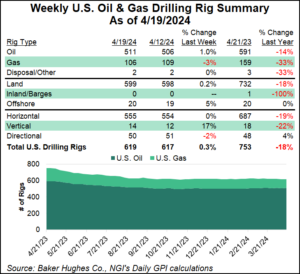Markets | LNG Insight | NGI All News Access
LNG Recap: Lack of Export Demand has U.S. Storage on Track to Fill by Fall
Feed gas deliveries to U.S. LNG terminals hit a new low last week as global prices are still weighed down by a supply glut and demand for American exports remains subdued given high storage inventories in Asia and Europe.
Genscape Inc. noted that feed gas volumes fell to 2.8 Bcf on Thursday, while NGI’s export tracker showed them at 2.9 Bcf. That’s about 1 Bcf/d less than June’s average. Feed gas had bounced back slightly on Friday to more than 3 Bcf/d.
European storage inventories were at about 82% of capacity as the week came to a close and are expected to fill by the end of injection season. Inventories are also high in Asia, which has kept prices depressed and spot activity subdued.
Meanwhile, a new dynamic is shaping up in the United States as the lack of export demand could find storage full by the fall. The Energy Information Administration forecast this month that working gas in storage could reach more than 4 Tcf at the end of October, the highest monthly total on record and only 5% below EIA’s estimate of demonstrated peak capacity, ClearView Energy Partners LLC recently noted. While the glut is weighing on near-term gas balances, it’s also pushing down U.S. prices to levels not seen in years.
Bloomberg New Energy Finance (BNEF) estimated that low European prices in particular could cut 19 billion cubic meters (Bcm) of U.S. LNG exports between the second and third quarters, or roughly 45% of U.S. export capacity. EIA said in its latest Short-Term Energy Outlook that 110 U.S. cargoes were canceled for June-August lifting. Meanwhile, BNEF says up to 140 cargoes could be canceled in the third quarter.
U.S. LNG remains uneconomic as it would cost more to move it to key markets in Asia and Europe in the coming months. NGI calculations show the Gulf Coast to Asia arbitrage spread in negative territory until September, while the spread between the United States and Europe is negative until October. It would cost even more to move LNG overseas for those that don’t have vessels chartered.
European gas prices declined across the curve in Friday trading as well. While maintenance on the Nord Stream pipeline could tighten the prompt month, higher Russian flows from other routes combined with increasing Norwegian flows to Europe are keeping pressure on prices there, said Schneider Electric analyst Balint Balazs in a note to clients on Friday. While the lack of LNG imports, particularly from the U.S., has helped to balance the European market in recent weeks, Balazs noted that European LNG imports have picked up this month, with 62 cargoes arriving during the first 10 days of July.
The loose market still has floating LNG storage levels elevated worldwide. According to ClipperData, there were 23 vessels floating with LNG aboard on Friday, down only slightly from 25 earlier in the week.
BNEF said floating storage is likely to increase in the coming months, especially in certain markets. Given a steep contango in North Asian prices, traders are likely to delay unloading in September and October, when they can make about 3 cents/MMBtu if they wait longer, said BNEF analysts Verena Viskovic and Anna Borisova.
“Price-driven floating storage in September may help defer 2.7 Bcm of LNG supply from” the third to fourth quarter, the analysts said. “This is the same volume of floating storage identified during the shoulder season last year when the profitability of such operations was similar.”
In other news last week, the Federal Energy Regulatory Commission cleared Kinder Morgan Inc. to introduce mixed refrigerant to unit 9 at the Elba Island LNG export facility in Georgia. Four of the facility’s six movable modular liquefaction units have yet to enter service, but the company has said it plans to bring them all online by the end of the summer. Elba’s first export cargo left late last year.
© 2024 Natural Gas Intelligence. All rights reserved.
ISSN © 1532-1231 | ISSN © 2577-9877 |


